The Significance of Diversity in Modern Management Principles
VerifiedAdded on 2021/05/31
|12
|2849
|24
Essay
AI Summary
This essay delves into the critical role of diversity within the framework of management principles, examining its multifaceted impact on organizational dynamics. It begins by defining diversity and its various dimensions, setting the stage for an analysis of how diversity influences workplace environments, team effectiveness, and overall organizational performance. The essay explores the evolution of diversity management, highlighting its importance in fostering creativity, innovation, and effective problem-solving within teams. It analyzes the cognitive diversity and its positive effects on teamwork. Furthermore, it examines how diverse perspectives contribute to improved decision-making, innovation, and creativity. The essay also explores how diversity impacts the quantity and quality of team outcomes, including social integration. It concludes by emphasizing the strategic advantages of managing a diverse workforce, including increased productivity, growth and learning opportunities, effective communication, and a diversified experience. The essay underscores the importance of adapting organizational techniques to effectively leverage diversity for achieving competitive advantages and enhancing organizational efficacy.
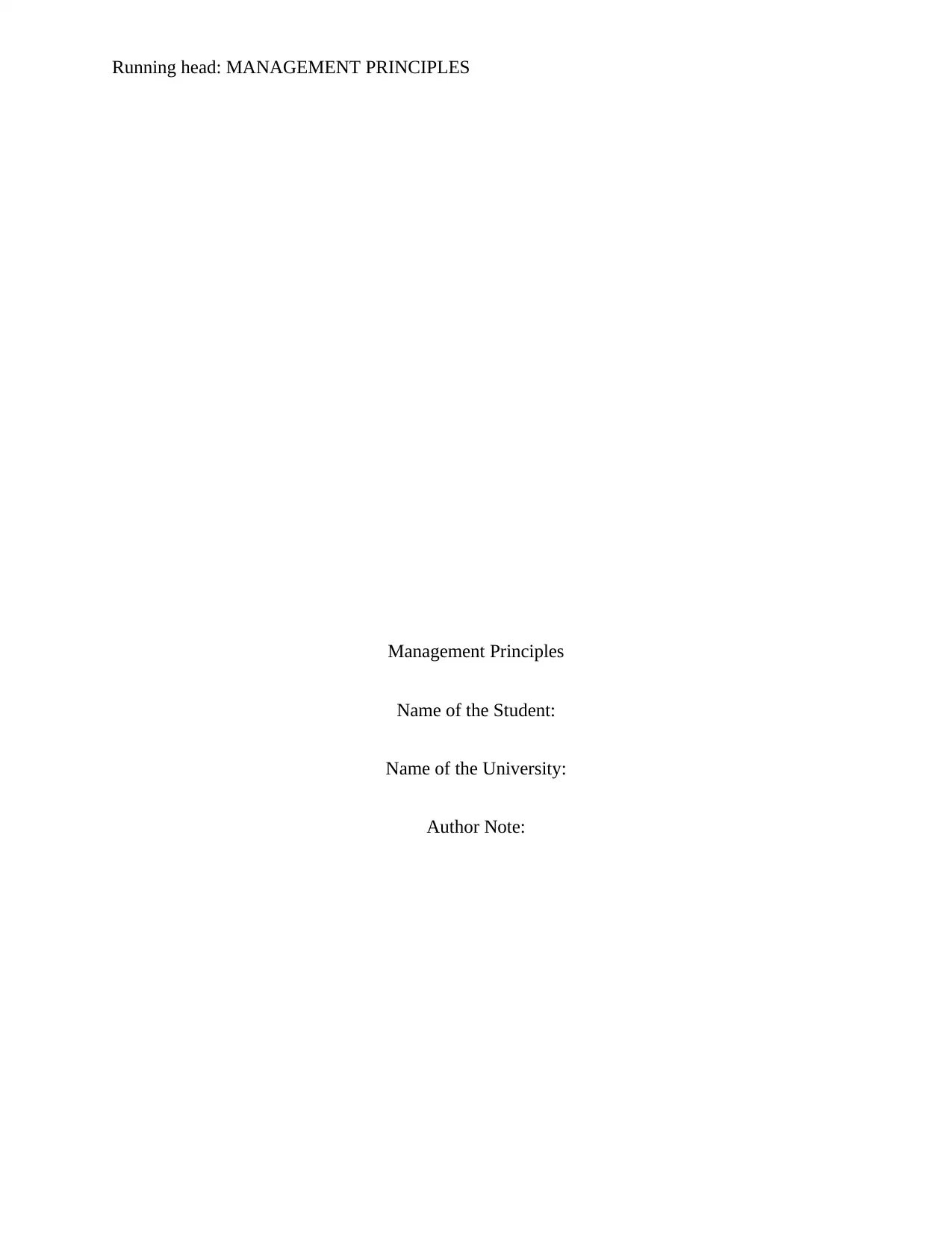
Running head: MANAGEMENT PRINCIPLES
Management Principles
Name of the Student:
Name of the University:
Author Note:
Management Principles
Name of the Student:
Name of the University:
Author Note:
Paraphrase This Document
Need a fresh take? Get an instant paraphrase of this document with our AI Paraphraser
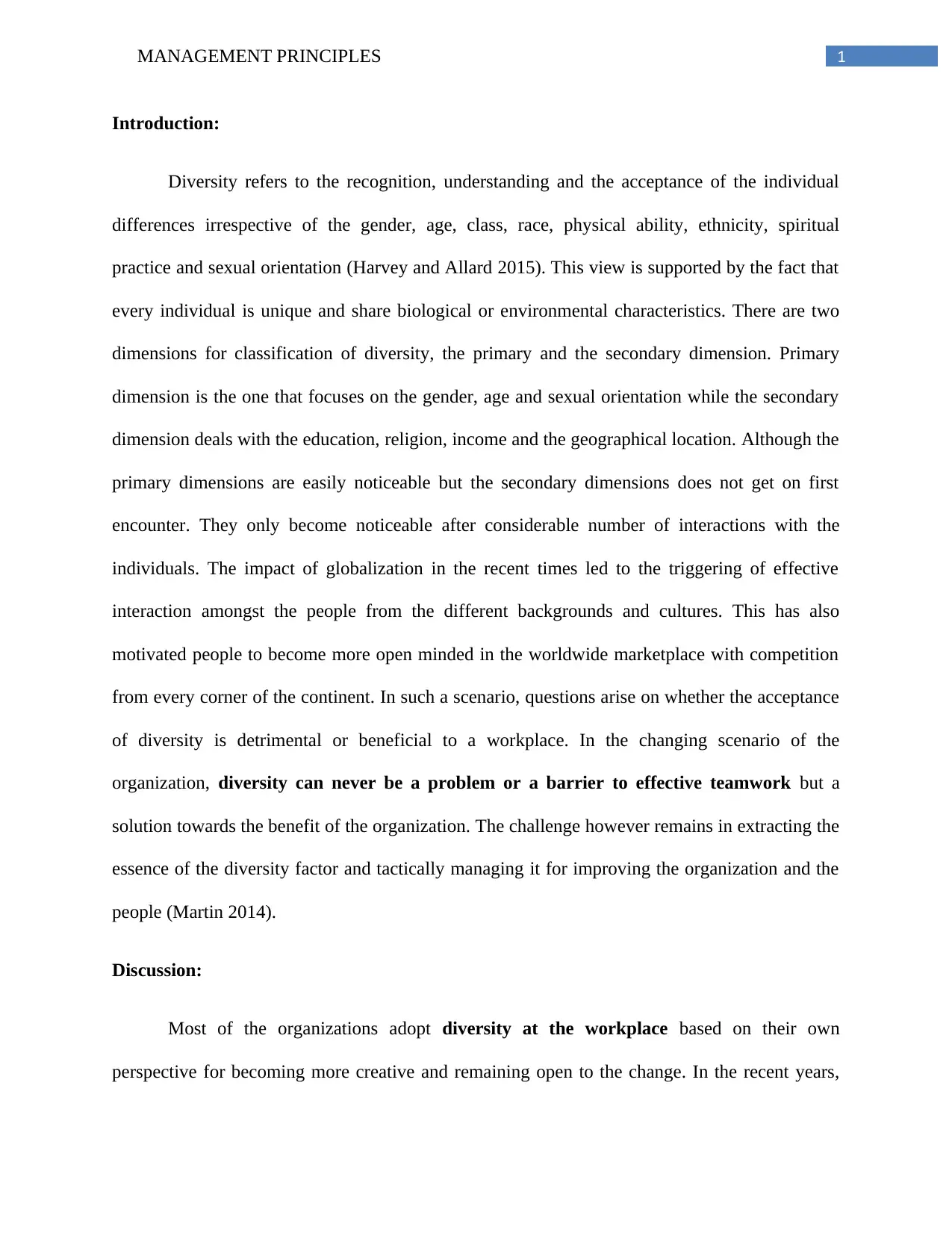
1MANAGEMENT PRINCIPLES
Introduction:
Diversity refers to the recognition, understanding and the acceptance of the individual
differences irrespective of the gender, age, class, race, physical ability, ethnicity, spiritual
practice and sexual orientation (Harvey and Allard 2015). This view is supported by the fact that
every individual is unique and share biological or environmental characteristics. There are two
dimensions for classification of diversity, the primary and the secondary dimension. Primary
dimension is the one that focuses on the gender, age and sexual orientation while the secondary
dimension deals with the education, religion, income and the geographical location. Although the
primary dimensions are easily noticeable but the secondary dimensions does not get on first
encounter. They only become noticeable after considerable number of interactions with the
individuals. The impact of globalization in the recent times led to the triggering of effective
interaction amongst the people from the different backgrounds and cultures. This has also
motivated people to become more open minded in the worldwide marketplace with competition
from every corner of the continent. In such a scenario, questions arise on whether the acceptance
of diversity is detrimental or beneficial to a workplace. In the changing scenario of the
organization, diversity can never be a problem or a barrier to effective teamwork but a
solution towards the benefit of the organization. The challenge however remains in extracting the
essence of the diversity factor and tactically managing it for improving the organization and the
people (Martin 2014).
Discussion:
Most of the organizations adopt diversity at the workplace based on their own
perspective for becoming more creative and remaining open to the change. In the recent years,
Introduction:
Diversity refers to the recognition, understanding and the acceptance of the individual
differences irrespective of the gender, age, class, race, physical ability, ethnicity, spiritual
practice and sexual orientation (Harvey and Allard 2015). This view is supported by the fact that
every individual is unique and share biological or environmental characteristics. There are two
dimensions for classification of diversity, the primary and the secondary dimension. Primary
dimension is the one that focuses on the gender, age and sexual orientation while the secondary
dimension deals with the education, religion, income and the geographical location. Although the
primary dimensions are easily noticeable but the secondary dimensions does not get on first
encounter. They only become noticeable after considerable number of interactions with the
individuals. The impact of globalization in the recent times led to the triggering of effective
interaction amongst the people from the different backgrounds and cultures. This has also
motivated people to become more open minded in the worldwide marketplace with competition
from every corner of the continent. In such a scenario, questions arise on whether the acceptance
of diversity is detrimental or beneficial to a workplace. In the changing scenario of the
organization, diversity can never be a problem or a barrier to effective teamwork but a
solution towards the benefit of the organization. The challenge however remains in extracting the
essence of the diversity factor and tactically managing it for improving the organization and the
people (Martin 2014).
Discussion:
Most of the organizations adopt diversity at the workplace based on their own
perspective for becoming more creative and remaining open to the change. In the recent years,
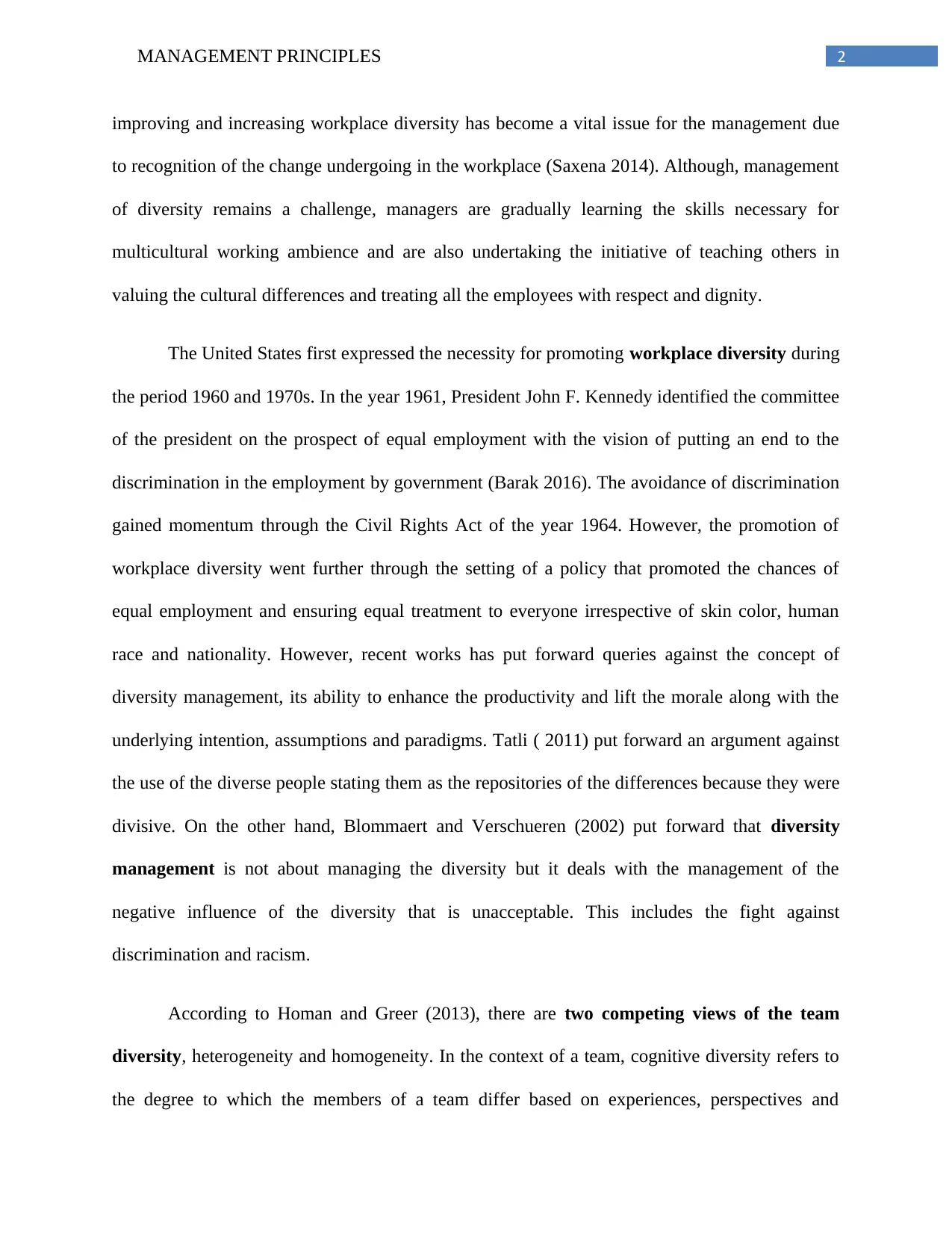
2MANAGEMENT PRINCIPLES
improving and increasing workplace diversity has become a vital issue for the management due
to recognition of the change undergoing in the workplace (Saxena 2014). Although, management
of diversity remains a challenge, managers are gradually learning the skills necessary for
multicultural working ambience and are also undertaking the initiative of teaching others in
valuing the cultural differences and treating all the employees with respect and dignity.
The United States first expressed the necessity for promoting workplace diversity during
the period 1960 and 1970s. In the year 1961, President John F. Kennedy identified the committee
of the president on the prospect of equal employment with the vision of putting an end to the
discrimination in the employment by government (Barak 2016). The avoidance of discrimination
gained momentum through the Civil Rights Act of the year 1964. However, the promotion of
workplace diversity went further through the setting of a policy that promoted the chances of
equal employment and ensuring equal treatment to everyone irrespective of skin color, human
race and nationality. However, recent works has put forward queries against the concept of
diversity management, its ability to enhance the productivity and lift the morale along with the
underlying intention, assumptions and paradigms. Tatli ( 2011) put forward an argument against
the use of the diverse people stating them as the repositories of the differences because they were
divisive. On the other hand, Blommaert and Verschueren (2002) put forward that diversity
management is not about managing the diversity but it deals with the management of the
negative influence of the diversity that is unacceptable. This includes the fight against
discrimination and racism.
According to Homan and Greer (2013), there are two competing views of the team
diversity, heterogeneity and homogeneity. In the context of a team, cognitive diversity refers to
the degree to which the members of a team differ based on experiences, perspectives and
improving and increasing workplace diversity has become a vital issue for the management due
to recognition of the change undergoing in the workplace (Saxena 2014). Although, management
of diversity remains a challenge, managers are gradually learning the skills necessary for
multicultural working ambience and are also undertaking the initiative of teaching others in
valuing the cultural differences and treating all the employees with respect and dignity.
The United States first expressed the necessity for promoting workplace diversity during
the period 1960 and 1970s. In the year 1961, President John F. Kennedy identified the committee
of the president on the prospect of equal employment with the vision of putting an end to the
discrimination in the employment by government (Barak 2016). The avoidance of discrimination
gained momentum through the Civil Rights Act of the year 1964. However, the promotion of
workplace diversity went further through the setting of a policy that promoted the chances of
equal employment and ensuring equal treatment to everyone irrespective of skin color, human
race and nationality. However, recent works has put forward queries against the concept of
diversity management, its ability to enhance the productivity and lift the morale along with the
underlying intention, assumptions and paradigms. Tatli ( 2011) put forward an argument against
the use of the diverse people stating them as the repositories of the differences because they were
divisive. On the other hand, Blommaert and Verschueren (2002) put forward that diversity
management is not about managing the diversity but it deals with the management of the
negative influence of the diversity that is unacceptable. This includes the fight against
discrimination and racism.
According to Homan and Greer (2013), there are two competing views of the team
diversity, heterogeneity and homogeneity. In the context of a team, cognitive diversity refers to
the degree to which the members of a team differ based on experiences, perspectives and
⊘ This is a preview!⊘
Do you want full access?
Subscribe today to unlock all pages.

Trusted by 1+ million students worldwide
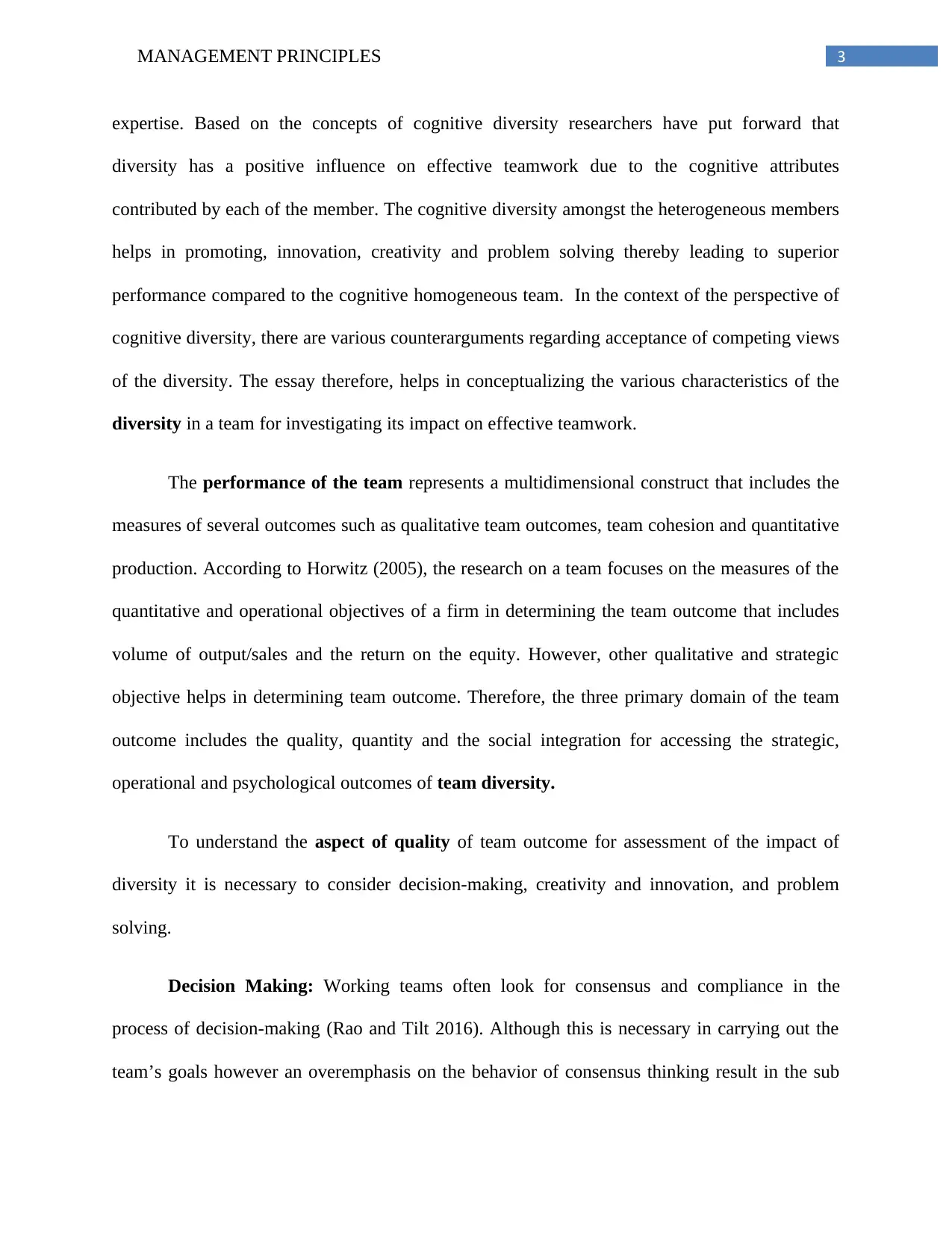
3MANAGEMENT PRINCIPLES
expertise. Based on the concepts of cognitive diversity researchers have put forward that
diversity has a positive influence on effective teamwork due to the cognitive attributes
contributed by each of the member. The cognitive diversity amongst the heterogeneous members
helps in promoting, innovation, creativity and problem solving thereby leading to superior
performance compared to the cognitive homogeneous team. In the context of the perspective of
cognitive diversity, there are various counterarguments regarding acceptance of competing views
of the diversity. The essay therefore, helps in conceptualizing the various characteristics of the
diversity in a team for investigating its impact on effective teamwork.
The performance of the team represents a multidimensional construct that includes the
measures of several outcomes such as qualitative team outcomes, team cohesion and quantitative
production. According to Horwitz (2005), the research on a team focuses on the measures of the
quantitative and operational objectives of a firm in determining the team outcome that includes
volume of output/sales and the return on the equity. However, other qualitative and strategic
objective helps in determining team outcome. Therefore, the three primary domain of the team
outcome includes the quality, quantity and the social integration for accessing the strategic,
operational and psychological outcomes of team diversity.
To understand the aspect of quality of team outcome for assessment of the impact of
diversity it is necessary to consider decision-making, creativity and innovation, and problem
solving.
Decision Making: Working teams often look for consensus and compliance in the
process of decision-making (Rao and Tilt 2016). Although this is necessary in carrying out the
team’s goals however an overemphasis on the behavior of consensus thinking result in the sub
expertise. Based on the concepts of cognitive diversity researchers have put forward that
diversity has a positive influence on effective teamwork due to the cognitive attributes
contributed by each of the member. The cognitive diversity amongst the heterogeneous members
helps in promoting, innovation, creativity and problem solving thereby leading to superior
performance compared to the cognitive homogeneous team. In the context of the perspective of
cognitive diversity, there are various counterarguments regarding acceptance of competing views
of the diversity. The essay therefore, helps in conceptualizing the various characteristics of the
diversity in a team for investigating its impact on effective teamwork.
The performance of the team represents a multidimensional construct that includes the
measures of several outcomes such as qualitative team outcomes, team cohesion and quantitative
production. According to Horwitz (2005), the research on a team focuses on the measures of the
quantitative and operational objectives of a firm in determining the team outcome that includes
volume of output/sales and the return on the equity. However, other qualitative and strategic
objective helps in determining team outcome. Therefore, the three primary domain of the team
outcome includes the quality, quantity and the social integration for accessing the strategic,
operational and psychological outcomes of team diversity.
To understand the aspect of quality of team outcome for assessment of the impact of
diversity it is necessary to consider decision-making, creativity and innovation, and problem
solving.
Decision Making: Working teams often look for consensus and compliance in the
process of decision-making (Rao and Tilt 2016). Although this is necessary in carrying out the
team’s goals however an overemphasis on the behavior of consensus thinking result in the sub
Paraphrase This Document
Need a fresh take? Get an instant paraphrase of this document with our AI Paraphraser
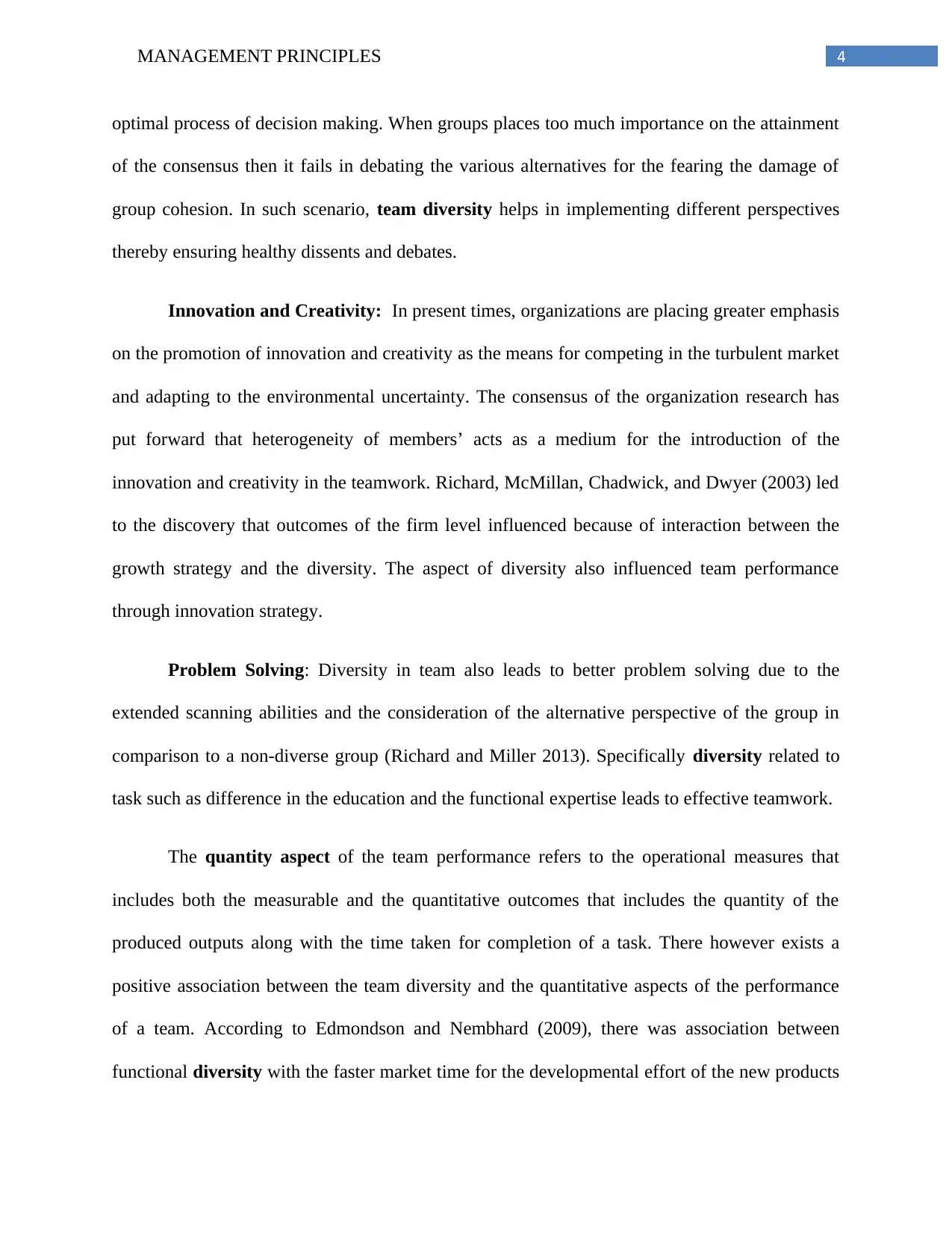
4MANAGEMENT PRINCIPLES
optimal process of decision making. When groups places too much importance on the attainment
of the consensus then it fails in debating the various alternatives for the fearing the damage of
group cohesion. In such scenario, team diversity helps in implementing different perspectives
thereby ensuring healthy dissents and debates.
Innovation and Creativity: In present times, organizations are placing greater emphasis
on the promotion of innovation and creativity as the means for competing in the turbulent market
and adapting to the environmental uncertainty. The consensus of the organization research has
put forward that heterogeneity of members’ acts as a medium for the introduction of the
innovation and creativity in the teamwork. Richard, McMillan, Chadwick, and Dwyer (2003) led
to the discovery that outcomes of the firm level influenced because of interaction between the
growth strategy and the diversity. The aspect of diversity also influenced team performance
through innovation strategy.
Problem Solving: Diversity in team also leads to better problem solving due to the
extended scanning abilities and the consideration of the alternative perspective of the group in
comparison to a non-diverse group (Richard and Miller 2013). Specifically diversity related to
task such as difference in the education and the functional expertise leads to effective teamwork.
The quantity aspect of the team performance refers to the operational measures that
includes both the measurable and the quantitative outcomes that includes the quantity of the
produced outputs along with the time taken for completion of a task. There however exists a
positive association between the team diversity and the quantitative aspects of the performance
of a team. According to Edmondson and Nembhard (2009), there was association between
functional diversity with the faster market time for the developmental effort of the new products
optimal process of decision making. When groups places too much importance on the attainment
of the consensus then it fails in debating the various alternatives for the fearing the damage of
group cohesion. In such scenario, team diversity helps in implementing different perspectives
thereby ensuring healthy dissents and debates.
Innovation and Creativity: In present times, organizations are placing greater emphasis
on the promotion of innovation and creativity as the means for competing in the turbulent market
and adapting to the environmental uncertainty. The consensus of the organization research has
put forward that heterogeneity of members’ acts as a medium for the introduction of the
innovation and creativity in the teamwork. Richard, McMillan, Chadwick, and Dwyer (2003) led
to the discovery that outcomes of the firm level influenced because of interaction between the
growth strategy and the diversity. The aspect of diversity also influenced team performance
through innovation strategy.
Problem Solving: Diversity in team also leads to better problem solving due to the
extended scanning abilities and the consideration of the alternative perspective of the group in
comparison to a non-diverse group (Richard and Miller 2013). Specifically diversity related to
task such as difference in the education and the functional expertise leads to effective teamwork.
The quantity aspect of the team performance refers to the operational measures that
includes both the measurable and the quantitative outcomes that includes the quantity of the
produced outputs along with the time taken for completion of a task. There however exists a
positive association between the team diversity and the quantitative aspects of the performance
of a team. According to Edmondson and Nembhard (2009), there was association between
functional diversity with the faster market time for the developmental effort of the new products
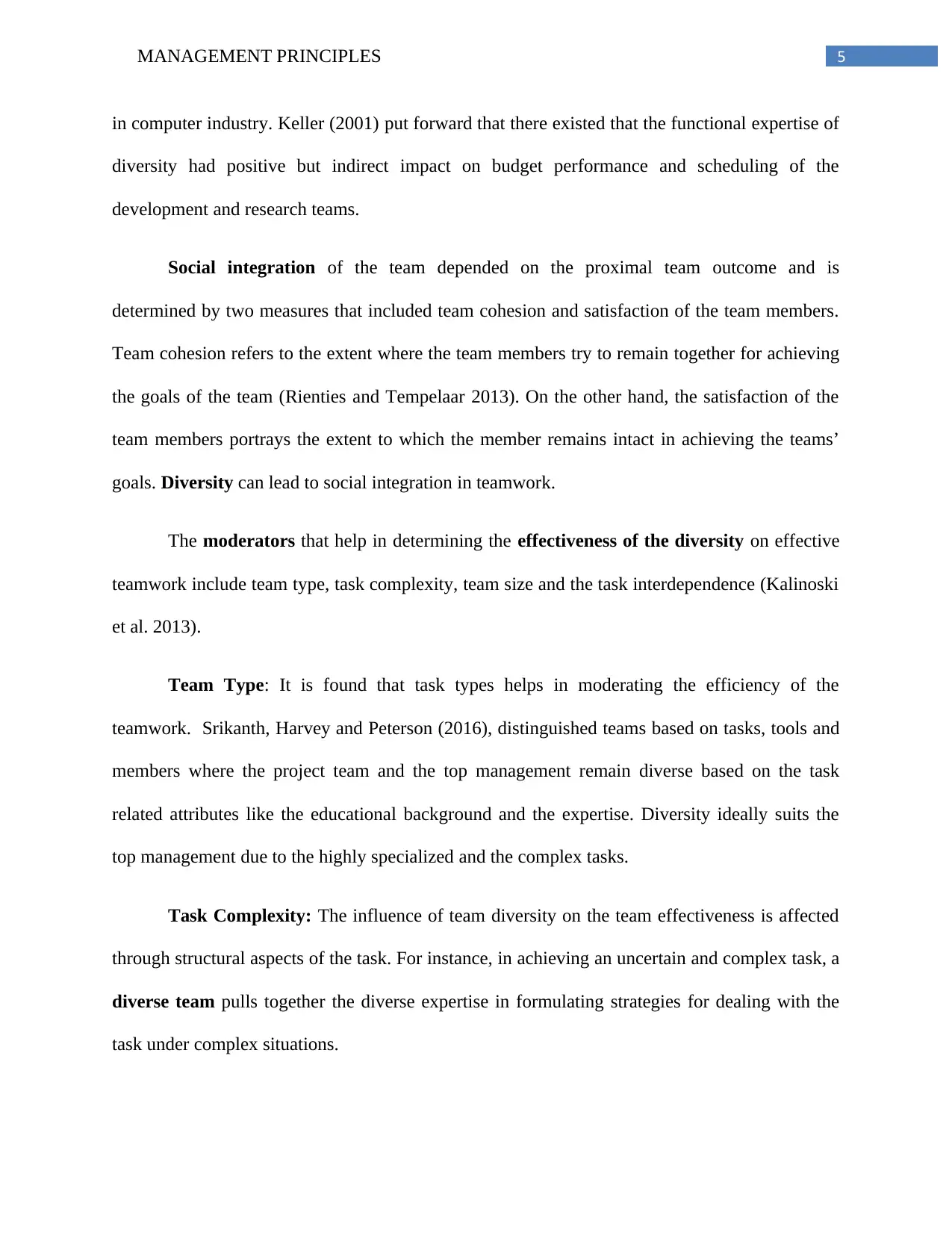
5MANAGEMENT PRINCIPLES
in computer industry. Keller (2001) put forward that there existed that the functional expertise of
diversity had positive but indirect impact on budget performance and scheduling of the
development and research teams.
Social integration of the team depended on the proximal team outcome and is
determined by two measures that included team cohesion and satisfaction of the team members.
Team cohesion refers to the extent where the team members try to remain together for achieving
the goals of the team (Rienties and Tempelaar 2013). On the other hand, the satisfaction of the
team members portrays the extent to which the member remains intact in achieving the teams’
goals. Diversity can lead to social integration in teamwork.
The moderators that help in determining the effectiveness of the diversity on effective
teamwork include team type, task complexity, team size and the task interdependence (Kalinoski
et al. 2013).
Team Type: It is found that task types helps in moderating the efficiency of the
teamwork. Srikanth, Harvey and Peterson (2016), distinguished teams based on tasks, tools and
members where the project team and the top management remain diverse based on the task
related attributes like the educational background and the expertise. Diversity ideally suits the
top management due to the highly specialized and the complex tasks.
Task Complexity: The influence of team diversity on the team effectiveness is affected
through structural aspects of the task. For instance, in achieving an uncertain and complex task, a
diverse team pulls together the diverse expertise in formulating strategies for dealing with the
task under complex situations.
in computer industry. Keller (2001) put forward that there existed that the functional expertise of
diversity had positive but indirect impact on budget performance and scheduling of the
development and research teams.
Social integration of the team depended on the proximal team outcome and is
determined by two measures that included team cohesion and satisfaction of the team members.
Team cohesion refers to the extent where the team members try to remain together for achieving
the goals of the team (Rienties and Tempelaar 2013). On the other hand, the satisfaction of the
team members portrays the extent to which the member remains intact in achieving the teams’
goals. Diversity can lead to social integration in teamwork.
The moderators that help in determining the effectiveness of the diversity on effective
teamwork include team type, task complexity, team size and the task interdependence (Kalinoski
et al. 2013).
Team Type: It is found that task types helps in moderating the efficiency of the
teamwork. Srikanth, Harvey and Peterson (2016), distinguished teams based on tasks, tools and
members where the project team and the top management remain diverse based on the task
related attributes like the educational background and the expertise. Diversity ideally suits the
top management due to the highly specialized and the complex tasks.
Task Complexity: The influence of team diversity on the team effectiveness is affected
through structural aspects of the task. For instance, in achieving an uncertain and complex task, a
diverse team pulls together the diverse expertise in formulating strategies for dealing with the
task under complex situations.
⊘ This is a preview!⊘
Do you want full access?
Subscribe today to unlock all pages.

Trusted by 1+ million students worldwide
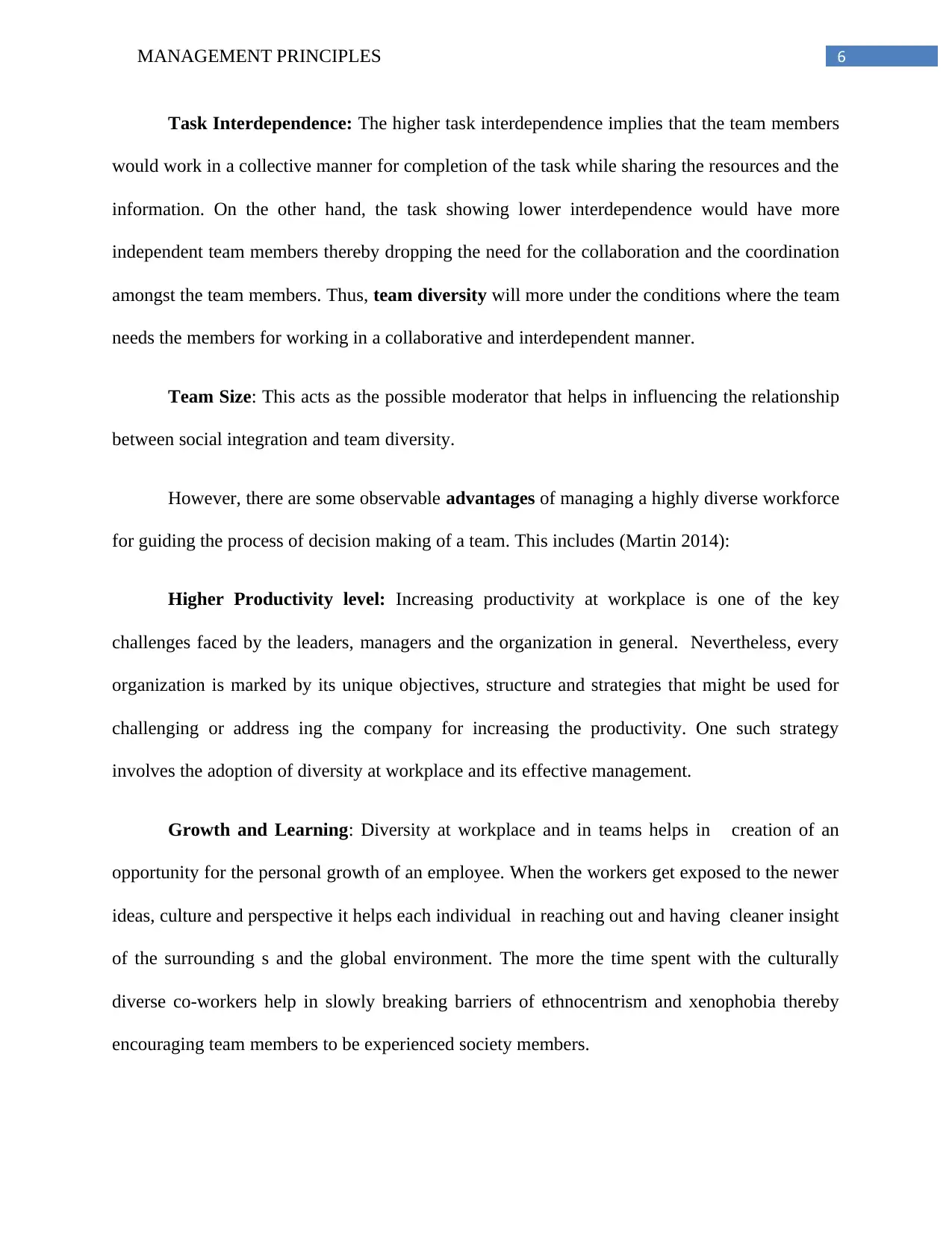
6MANAGEMENT PRINCIPLES
Task Interdependence: The higher task interdependence implies that the team members
would work in a collective manner for completion of the task while sharing the resources and the
information. On the other hand, the task showing lower interdependence would have more
independent team members thereby dropping the need for the collaboration and the coordination
amongst the team members. Thus, team diversity will more under the conditions where the team
needs the members for working in a collaborative and interdependent manner.
Team Size: This acts as the possible moderator that helps in influencing the relationship
between social integration and team diversity.
However, there are some observable advantages of managing a highly diverse workforce
for guiding the process of decision making of a team. This includes (Martin 2014):
Higher Productivity level: Increasing productivity at workplace is one of the key
challenges faced by the leaders, managers and the organization in general. Nevertheless, every
organization is marked by its unique objectives, structure and strategies that might be used for
challenging or address ing the company for increasing the productivity. One such strategy
involves the adoption of diversity at workplace and its effective management.
Growth and Learning: Diversity at workplace and in teams helps in creation of an
opportunity for the personal growth of an employee. When the workers get exposed to the newer
ideas, culture and perspective it helps each individual in reaching out and having cleaner insight
of the surrounding s and the global environment. The more the time spent with the culturally
diverse co-workers help in slowly breaking barriers of ethnocentrism and xenophobia thereby
encouraging team members to be experienced society members.
Task Interdependence: The higher task interdependence implies that the team members
would work in a collective manner for completion of the task while sharing the resources and the
information. On the other hand, the task showing lower interdependence would have more
independent team members thereby dropping the need for the collaboration and the coordination
amongst the team members. Thus, team diversity will more under the conditions where the team
needs the members for working in a collaborative and interdependent manner.
Team Size: This acts as the possible moderator that helps in influencing the relationship
between social integration and team diversity.
However, there are some observable advantages of managing a highly diverse workforce
for guiding the process of decision making of a team. This includes (Martin 2014):
Higher Productivity level: Increasing productivity at workplace is one of the key
challenges faced by the leaders, managers and the organization in general. Nevertheless, every
organization is marked by its unique objectives, structure and strategies that might be used for
challenging or address ing the company for increasing the productivity. One such strategy
involves the adoption of diversity at workplace and its effective management.
Growth and Learning: Diversity at workplace and in teams helps in creation of an
opportunity for the personal growth of an employee. When the workers get exposed to the newer
ideas, culture and perspective it helps each individual in reaching out and having cleaner insight
of the surrounding s and the global environment. The more the time spent with the culturally
diverse co-workers help in slowly breaking barriers of ethnocentrism and xenophobia thereby
encouraging team members to be experienced society members.
Paraphrase This Document
Need a fresh take? Get an instant paraphrase of this document with our AI Paraphraser
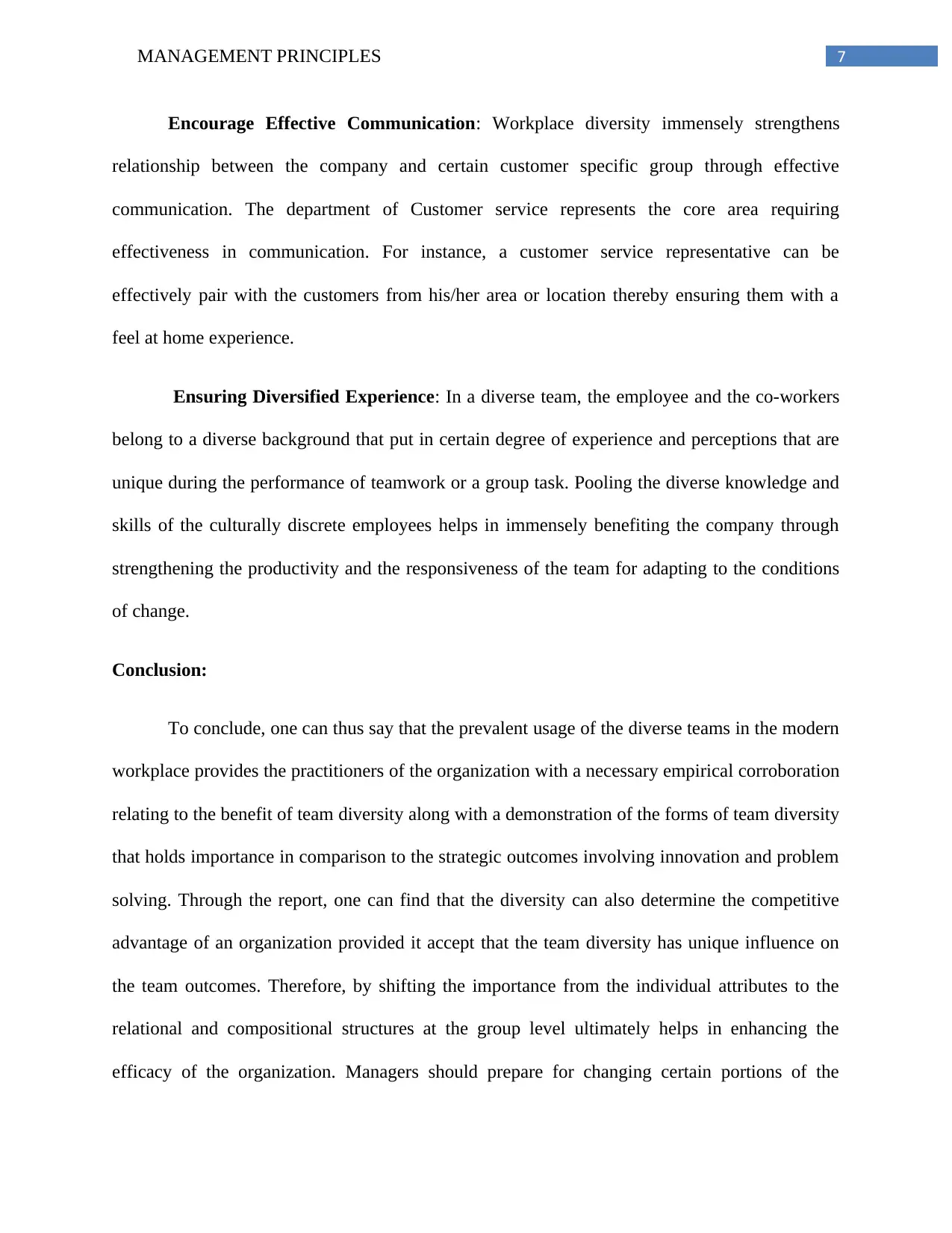
7MANAGEMENT PRINCIPLES
Encourage Effective Communication: Workplace diversity immensely strengthens
relationship between the company and certain customer specific group through effective
communication. The department of Customer service represents the core area requiring
effectiveness in communication. For instance, a customer service representative can be
effectively pair with the customers from his/her area or location thereby ensuring them with a
feel at home experience.
Ensuring Diversified Experience: In a diverse team, the employee and the co-workers
belong to a diverse background that put in certain degree of experience and perceptions that are
unique during the performance of teamwork or a group task. Pooling the diverse knowledge and
skills of the culturally discrete employees helps in immensely benefiting the company through
strengthening the productivity and the responsiveness of the team for adapting to the conditions
of change.
Conclusion:
To conclude, one can thus say that the prevalent usage of the diverse teams in the modern
workplace provides the practitioners of the organization with a necessary empirical corroboration
relating to the benefit of team diversity along with a demonstration of the forms of team diversity
that holds importance in comparison to the strategic outcomes involving innovation and problem
solving. Through the report, one can find that the diversity can also determine the competitive
advantage of an organization provided it accept that the team diversity has unique influence on
the team outcomes. Therefore, by shifting the importance from the individual attributes to the
relational and compositional structures at the group level ultimately helps in enhancing the
efficacy of the organization. Managers should prepare for changing certain portions of the
Encourage Effective Communication: Workplace diversity immensely strengthens
relationship between the company and certain customer specific group through effective
communication. The department of Customer service represents the core area requiring
effectiveness in communication. For instance, a customer service representative can be
effectively pair with the customers from his/her area or location thereby ensuring them with a
feel at home experience.
Ensuring Diversified Experience: In a diverse team, the employee and the co-workers
belong to a diverse background that put in certain degree of experience and perceptions that are
unique during the performance of teamwork or a group task. Pooling the diverse knowledge and
skills of the culturally discrete employees helps in immensely benefiting the company through
strengthening the productivity and the responsiveness of the team for adapting to the conditions
of change.
Conclusion:
To conclude, one can thus say that the prevalent usage of the diverse teams in the modern
workplace provides the practitioners of the organization with a necessary empirical corroboration
relating to the benefit of team diversity along with a demonstration of the forms of team diversity
that holds importance in comparison to the strategic outcomes involving innovation and problem
solving. Through the report, one can find that the diversity can also determine the competitive
advantage of an organization provided it accept that the team diversity has unique influence on
the team outcomes. Therefore, by shifting the importance from the individual attributes to the
relational and compositional structures at the group level ultimately helps in enhancing the
efficacy of the organization. Managers should prepare for changing certain portions of the
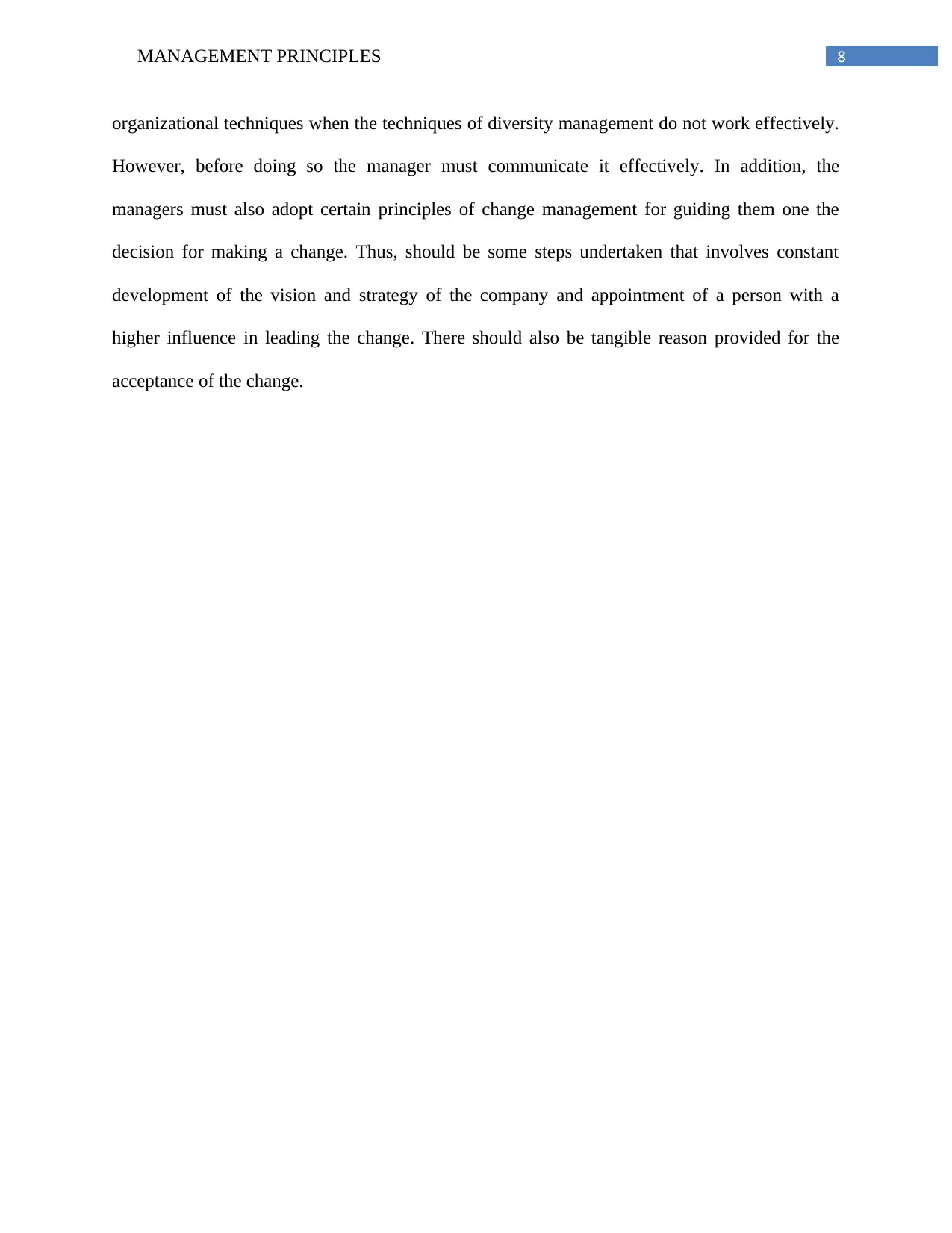
8MANAGEMENT PRINCIPLES
organizational techniques when the techniques of diversity management do not work effectively.
However, before doing so the manager must communicate it effectively. In addition, the
managers must also adopt certain principles of change management for guiding them one the
decision for making a change. Thus, should be some steps undertaken that involves constant
development of the vision and strategy of the company and appointment of a person with a
higher influence in leading the change. There should also be tangible reason provided for the
acceptance of the change.
organizational techniques when the techniques of diversity management do not work effectively.
However, before doing so the manager must communicate it effectively. In addition, the
managers must also adopt certain principles of change management for guiding them one the
decision for making a change. Thus, should be some steps undertaken that involves constant
development of the vision and strategy of the company and appointment of a person with a
higher influence in leading the change. There should also be tangible reason provided for the
acceptance of the change.
⊘ This is a preview!⊘
Do you want full access?
Subscribe today to unlock all pages.

Trusted by 1+ million students worldwide
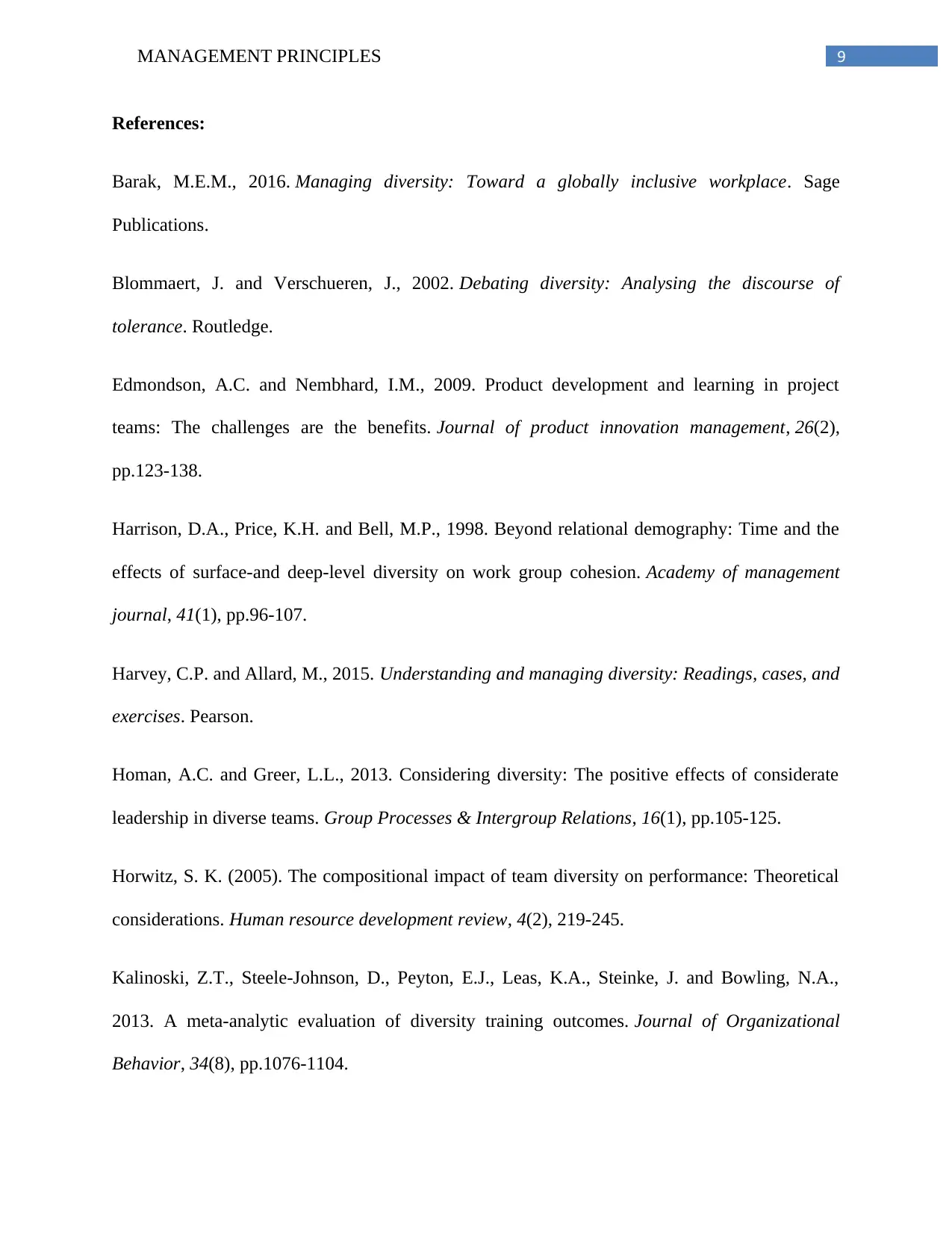
9MANAGEMENT PRINCIPLES
References:
Barak, M.E.M., 2016. Managing diversity: Toward a globally inclusive workplace. Sage
Publications.
Blommaert, J. and Verschueren, J., 2002. Debating diversity: Analysing the discourse of
tolerance. Routledge.
Edmondson, A.C. and Nembhard, I.M., 2009. Product development and learning in project
teams: The challenges are the benefits. Journal of product innovation management, 26(2),
pp.123-138.
Harrison, D.A., Price, K.H. and Bell, M.P., 1998. Beyond relational demography: Time and the
effects of surface-and deep-level diversity on work group cohesion. Academy of management
journal, 41(1), pp.96-107.
Harvey, C.P. and Allard, M., 2015. Understanding and managing diversity: Readings, cases, and
exercises. Pearson.
Homan, A.C. and Greer, L.L., 2013. Considering diversity: The positive effects of considerate
leadership in diverse teams. Group Processes & Intergroup Relations, 16(1), pp.105-125.
Horwitz, S. K. (2005). The compositional impact of team diversity on performance: Theoretical
considerations. Human resource development review, 4(2), 219-245.
Kalinoski, Z.T., Steele‐Johnson, D., Peyton, E.J., Leas, K.A., Steinke, J. and Bowling, N.A.,
2013. A meta‐analytic evaluation of diversity training outcomes. Journal of Organizational
Behavior, 34(8), pp.1076-1104.
References:
Barak, M.E.M., 2016. Managing diversity: Toward a globally inclusive workplace. Sage
Publications.
Blommaert, J. and Verschueren, J., 2002. Debating diversity: Analysing the discourse of
tolerance. Routledge.
Edmondson, A.C. and Nembhard, I.M., 2009. Product development and learning in project
teams: The challenges are the benefits. Journal of product innovation management, 26(2),
pp.123-138.
Harrison, D.A., Price, K.H. and Bell, M.P., 1998. Beyond relational demography: Time and the
effects of surface-and deep-level diversity on work group cohesion. Academy of management
journal, 41(1), pp.96-107.
Harvey, C.P. and Allard, M., 2015. Understanding and managing diversity: Readings, cases, and
exercises. Pearson.
Homan, A.C. and Greer, L.L., 2013. Considering diversity: The positive effects of considerate
leadership in diverse teams. Group Processes & Intergroup Relations, 16(1), pp.105-125.
Horwitz, S. K. (2005). The compositional impact of team diversity on performance: Theoretical
considerations. Human resource development review, 4(2), 219-245.
Kalinoski, Z.T., Steele‐Johnson, D., Peyton, E.J., Leas, K.A., Steinke, J. and Bowling, N.A.,
2013. A meta‐analytic evaluation of diversity training outcomes. Journal of Organizational
Behavior, 34(8), pp.1076-1104.
Paraphrase This Document
Need a fresh take? Get an instant paraphrase of this document with our AI Paraphraser
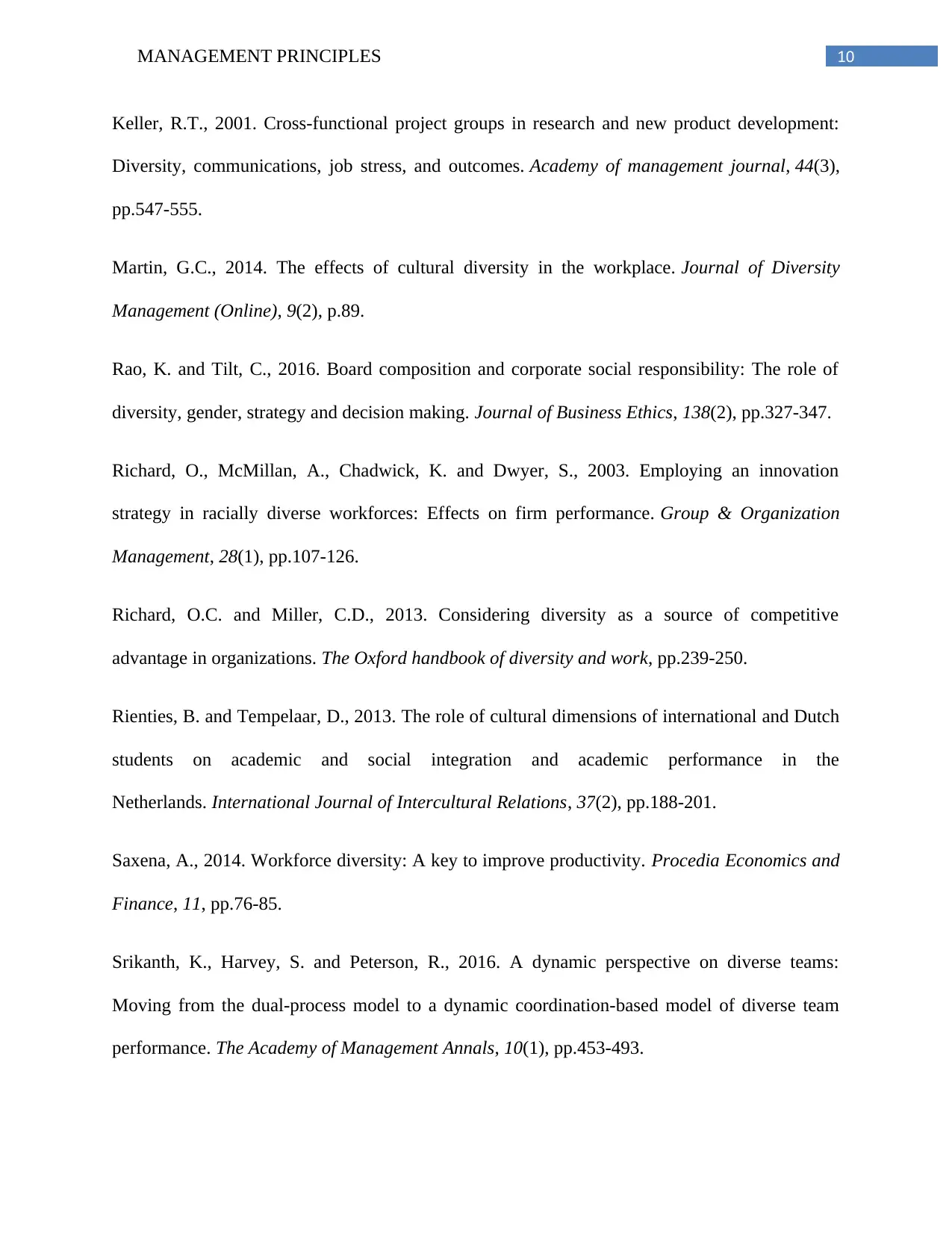
10MANAGEMENT PRINCIPLES
Keller, R.T., 2001. Cross-functional project groups in research and new product development:
Diversity, communications, job stress, and outcomes. Academy of management journal, 44(3),
pp.547-555.
Martin, G.C., 2014. The effects of cultural diversity in the workplace. Journal of Diversity
Management (Online), 9(2), p.89.
Rao, K. and Tilt, C., 2016. Board composition and corporate social responsibility: The role of
diversity, gender, strategy and decision making. Journal of Business Ethics, 138(2), pp.327-347.
Richard, O., McMillan, A., Chadwick, K. and Dwyer, S., 2003. Employing an innovation
strategy in racially diverse workforces: Effects on firm performance. Group & Organization
Management, 28(1), pp.107-126.
Richard, O.C. and Miller, C.D., 2013. Considering diversity as a source of competitive
advantage in organizations. The Oxford handbook of diversity and work, pp.239-250.
Rienties, B. and Tempelaar, D., 2013. The role of cultural dimensions of international and Dutch
students on academic and social integration and academic performance in the
Netherlands. International Journal of Intercultural Relations, 37(2), pp.188-201.
Saxena, A., 2014. Workforce diversity: A key to improve productivity. Procedia Economics and
Finance, 11, pp.76-85.
Srikanth, K., Harvey, S. and Peterson, R., 2016. A dynamic perspective on diverse teams:
Moving from the dual-process model to a dynamic coordination-based model of diverse team
performance. The Academy of Management Annals, 10(1), pp.453-493.
Keller, R.T., 2001. Cross-functional project groups in research and new product development:
Diversity, communications, job stress, and outcomes. Academy of management journal, 44(3),
pp.547-555.
Martin, G.C., 2014. The effects of cultural diversity in the workplace. Journal of Diversity
Management (Online), 9(2), p.89.
Rao, K. and Tilt, C., 2016. Board composition and corporate social responsibility: The role of
diversity, gender, strategy and decision making. Journal of Business Ethics, 138(2), pp.327-347.
Richard, O., McMillan, A., Chadwick, K. and Dwyer, S., 2003. Employing an innovation
strategy in racially diverse workforces: Effects on firm performance. Group & Organization
Management, 28(1), pp.107-126.
Richard, O.C. and Miller, C.D., 2013. Considering diversity as a source of competitive
advantage in organizations. The Oxford handbook of diversity and work, pp.239-250.
Rienties, B. and Tempelaar, D., 2013. The role of cultural dimensions of international and Dutch
students on academic and social integration and academic performance in the
Netherlands. International Journal of Intercultural Relations, 37(2), pp.188-201.
Saxena, A., 2014. Workforce diversity: A key to improve productivity. Procedia Economics and
Finance, 11, pp.76-85.
Srikanth, K., Harvey, S. and Peterson, R., 2016. A dynamic perspective on diverse teams:
Moving from the dual-process model to a dynamic coordination-based model of diverse team
performance. The Academy of Management Annals, 10(1), pp.453-493.
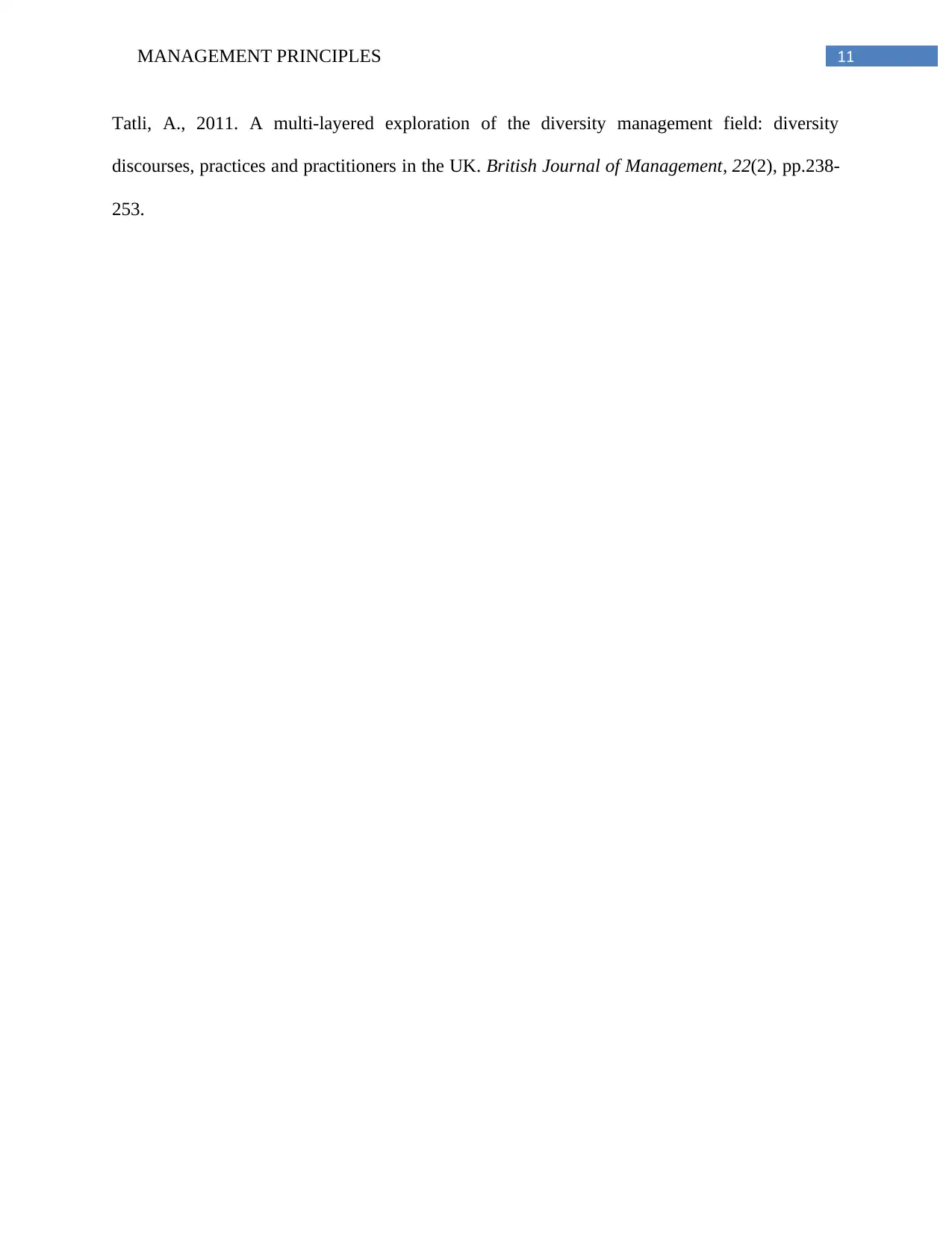
11MANAGEMENT PRINCIPLES
Tatli, A., 2011. A multi‐layered exploration of the diversity management field: diversity
discourses, practices and practitioners in the UK. British Journal of Management, 22(2), pp.238-
253.
Tatli, A., 2011. A multi‐layered exploration of the diversity management field: diversity
discourses, practices and practitioners in the UK. British Journal of Management, 22(2), pp.238-
253.
⊘ This is a preview!⊘
Do you want full access?
Subscribe today to unlock all pages.

Trusted by 1+ million students worldwide
1 out of 12
Related Documents
Your All-in-One AI-Powered Toolkit for Academic Success.
+13062052269
info@desklib.com
Available 24*7 on WhatsApp / Email
![[object Object]](/_next/static/media/star-bottom.7253800d.svg)
Unlock your academic potential
Copyright © 2020–2025 A2Z Services. All Rights Reserved. Developed and managed by ZUCOL.





